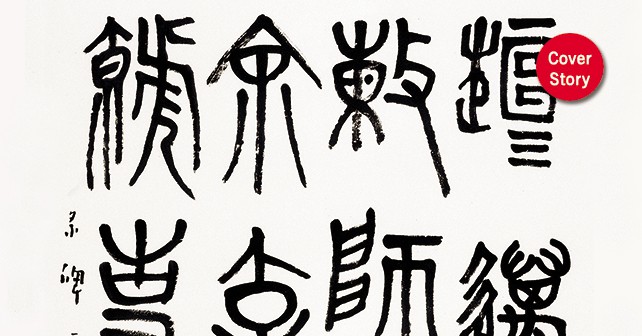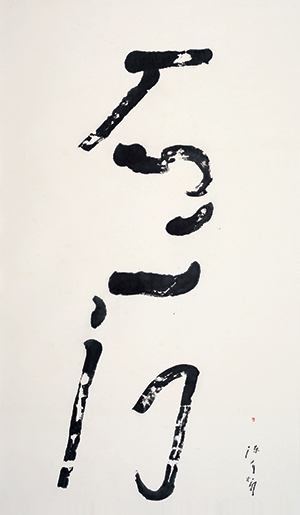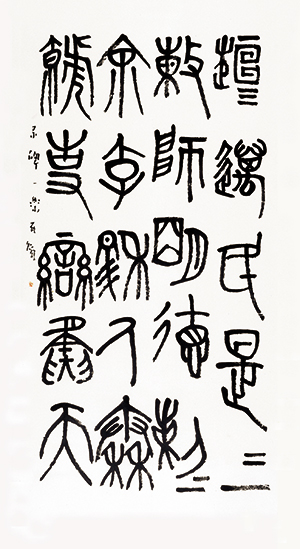
More than 2,000 years ago, Yang Xiong, the famous Han Dynasty Confucian scholar, defined calligraphy as the ventilation of the heart’s depths. The form, the handling of the brush, the presentation and style mean that calligraphy as a work of art is universally regarded in China as having the greatest power to reveal the moral integrity, character, emotions, aesthetics and culture of the artist.
This April, Sky One Art Gallery presents a new exhibition of the calligraphy work of acclaimed Singaporean artist Tan Oe Pang, whose extensive exploration of Chinese ink techniques, from calligraphy to landscapes, from the traditional to the daringly contemporary, mark him out as a visionary local artist without parallel.
Tan Oe Pang’s calligraphy gracefully inherits many centuries of tradition, while bringing it boldly into the present. His brushstrokes are often heavily imbued with recognisable traces of particular styles or forms, yet in his use of faint ink and dry strokes, the way in which he applies pressure or lifts the brush at the start and end of strokes, enlivens his characters with flourishes of modernity.

Tan Oe Pang, “Tian Fa Shen Qian Bei”, 2014, 218 x 110 cm
In traditional China, calligraphy – the art of writing – was the most highly prized of all visual art forms. Indeed, while painting and calligraphy emerged at the same time and shared the same tools – brush and ink – calligraphy was revered as a fine art long before painting. The high status of calligraphy reflects the importance of the word in traditional Chinese culture. But what makes Chinese written language so distinctive is its visual form, with each word represented by its own unique character.
It is said that Cangjie, the legendary inventor of Chinese writing, was inspired by seeing animal footprints and bird claw marks on the sand, based on which he developed simplified, easily recognizable images to denote single words. In calligraphy practice, these symbols convey more than phonetic sound or semantic meaning; the very way in which a character is rendered with brush and ink offers numerous connotations and readings, and reflects metaphors of human traits and natural elements.

Tan Oe Pang, “Tian Fa Shen Qian Bei”, 2014, 218 x 110 cm
As the 7th century writer Sun Guoting observed,
“[In calligraphy] I have seen the wonder of a drop of dew glistening from a dangling needle, a shower of rock hailing down in a raging thunder, a flock of geese gliding, frantic beasts stampeding in terror, a phoenix dancing, a startled snake slithering away in fright”.
Another facet that explains the significance of calligraphy is the existence of recognisable traditions or styles, alongside the calligrapher’s own distinct personal touch. The calligrapher must learn the choreographed movements of the characters and maintain compositional order, but once he has internalised these rules he is free to truly express himself. As abstract as it may at first seem to an untrained eye, calligraphy conveys emotion and the individual artist perhaps more intensely than all other Chinese visual arts.

Tan Oe Pang, “Zhen Shu”, 2000, 138 x 68 cm
When during the Song Dynasty and leading into the early 20th century the practices of calligraphy, poetry and ink painting became intertwined, this trinity of expression became known as the ‘three perfections’. It is no wonder then that during the end of the 19th and early 20th centuries, the abstract linear art of “calligraphic expressionism” would appear in the western art scene, and inspire many American abstract expressionists, including Jackson Pollock.
World renowned Chinese abstract artist Zhu Dequn has testified to the fact that the themes of the solid and the void, and the musical melody in abstract art, are derived from the intension of Chinese calligraphy. However, it may also be argued that western artists who draw from the essence of Chinese calligraphy only manage to take in its linear beauty. Chinese artists, on the other hand, have been able to nurture the inner strata of artistic creation because of their connection with the culture and philosophical thinking that informs calligraphy.
Tan Oe Pang is a highly accomplished calligraphy artist, whose mastery and innovation make the exhibition at Sky One Art Gallery particularly rewarding. While undeniably contemporary, his calligraphic art nevertheless contains much of the quintessence of ancient Chinese philosophy.
Tan’s regular script may be broadly categorised into two types. One category is simple and antiquated, attractive and pure, indicative of Jin and Tang styles, yet unrestrained by the brush and ink, appearing to have inherited more of the original flair of silk and wooden strip inscriptions. The other category is an innovation that departs completely from the shape of the characters, with the predominant subject matter being Buddhist teachings. In these works, the depths and intrinsic qualities of Chinese philosophy are emancipated from the words through the two-dimensionality of calligraphy into a spatial rendering, paving a new way for Chinese calligraphic art into modernity.
Written by Zoe Goldstein
Exhibition: The Calligraphy Art of Tan Oe Pang
Venue: Sky One Art Gallery
Address: 30 Tai Seng Street, #09-02, Breadtalk IHQ, Singapore 534013
Hours: Mon – Fri: 11am – 6pm; Sat, Sun & PH by appointment only
Website: www.oe-art.com






